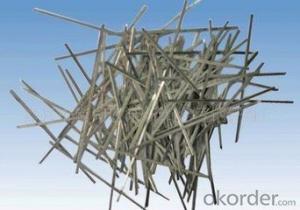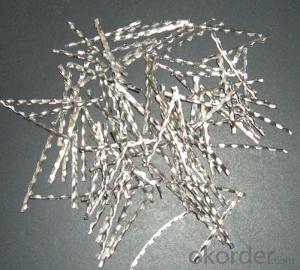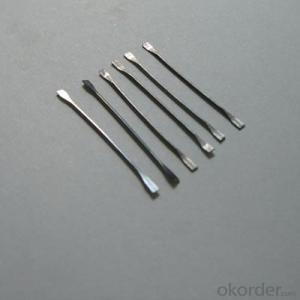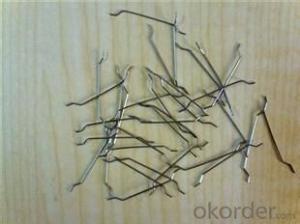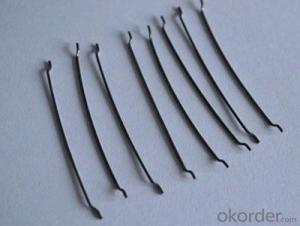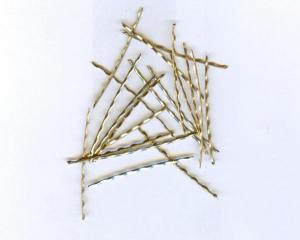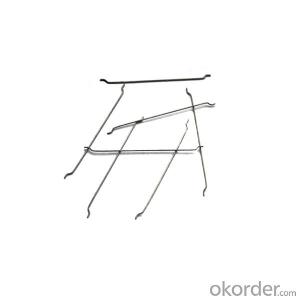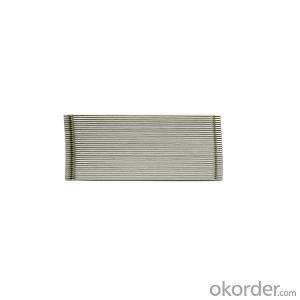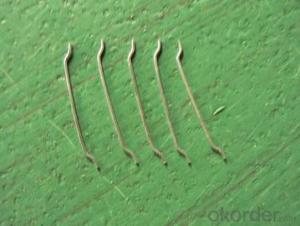Steel Fiber Loose From Company CNBM China
- Loading Port:
- Tianjin
- Payment Terms:
- TT OR LC
- Min Order Qty:
- 2000 kg
- Supply Capability:
- 30000 kg/month
OKorder Service Pledge
OKorder Financial Service
You Might Also Like
Quick Details
Place of Origin: Jiangsu, China (Mainland)
Model Number: HT-MC
Material: Color Steel
certificated: ISO 9001
Specifications
ISO 9001 certificated
2.70% for Europe, Middle Asia, America market
3.Have the most number of steel fiber machine in china
1. Material: low carbon steel wire or stainless steel
2.Diameter: 0.4mm-1.0mm
3.Length: meet your requirements
4.tensile strength >1000Mpa
6.Feature: excellent tensile,high tenacity,against cracking,impact and fatigue
7.Uses: highway road surface,tunnel,building,airport road surface and so on .
Straight Steel Fiber
1.ISO 9001 certificated
2.70% for Europe, Middle Asia, America market
3.Have the most number of steel fiber machine in china
Picture

Steel fiber
FAQ
certificated: ISO 9001
Technical advantages of Daye steel fiber:
A. Improve mechanical performance of concrete
B. Provide uniform distribution throughout concrete with excellent mixing
C. No balling or caking by adopt correct mixing method
D. Reduce concrete volume
E.Save construction time and cost
F.Reduce excavation volume
G.Available for jointless floor.
- Q:What is the optimal fiber volume fraction for melt extract stainless steel fiber in concrete?
- The optimal fiber volume fraction for melt extract stainless steel fiber in concrete can vary depending on the specific application and requirements. However, in general, a fiber volume fraction ranging from 0.5% to 2% is commonly recommended. At lower fiber volume fractions, such as 0.5% to 1%, stainless steel fibers can provide improved crack resistance and enhanced resistance to shrinkage and plastic settlement. These fibers help to distribute and control cracks in the concrete, reducing the risk of crack propagation and enhancing the overall durability and performance of the concrete. On the other hand, higher fiber volume fractions, around 1.5% to 2%, can be beneficial for applications that require higher tensile and flexural strength, such as industrial flooring or structures subject to heavy loads and high impact forces. The increased fiber content helps to reinforce the concrete matrix and enhance its ability to withstand these types of stresses. It is important to note that the optimal fiber volume fraction for melt extract stainless steel fiber in concrete should be determined based on specific project requirements, considering factors such as the desired level of crack control, load conditions, and the properties of the concrete mix. Consulting with a structural engineer or concrete expert can help in determining the most suitable fiber volume fraction for a given application.
- Q:How does melt extract stainless steel fiber improve the impact resistance of concrete pavers?
- Melt extract stainless steel fiber improves the impact resistance of concrete pavers through its unique properties and characteristics. When added to the concrete mix, these fibers act as reinforcing elements, providing enhanced toughness and durability to the pavers. The primary reason for the improved impact resistance is the high tensile strength of stainless steel fibers. These fibers are manufactured using a melt extraction process, which ensures a consistent and uniform distribution of fibers throughout the concrete matrix. This distribution helps in evenly dispersing the stress caused by an impact, preventing the concentration of forces on specific areas of the pavers. Furthermore, the stainless steel fibers also increase the flexural strength of the concrete pavers. This means that the pavers can withstand bending forces caused by impacts without cracking or breaking. The fibers act as a reinforcement network, reinforcing the cementitious matrix and preventing the propagation of cracks. In addition to the increased strength, stainless steel fibers also improve the overall durability of concrete pavers. The stainless steel material is highly resistant to corrosion, which is especially beneficial in outdoor or high-moisture environments. This resistance ensures that the fibers retain their strength and integrity over time, further enhancing the impact resistance of the pavers. Overall, melt extract stainless steel fiber significantly improves the impact resistance of concrete pavers by providing enhanced tensile strength, flexural strength, and durability. The incorporation of these fibers into the concrete mix results in pavers that can withstand heavy loads, impacts, and other external forces without compromising their structural integrity.
- Q:What is the impact of melt extract stainless steel fiber on the thermal properties of concrete?
- The impact of melt extract stainless steel fiber on the thermal properties of concrete is significant. Stainless steel fibers are added to concrete mixtures to enhance its thermal conductivity and heat resistance. These fibers act as heat conductors within the concrete matrix, allowing for better heat transfer throughout the structure. The addition of stainless steel fibers increases the thermal conductivity of concrete, which means that heat can be transferred more efficiently within the material. This can be beneficial in applications where heat dissipation is important, such as in the construction of high-temperature industrial facilities or fire-resistant structures. Moreover, stainless steel fibers help to reduce the risk of thermal cracking in concrete. When concrete is exposed to high temperatures, it undergoes thermal expansion, which can lead to cracking. By incorporating stainless steel fibers, the heat is distributed more evenly throughout the concrete, reducing the likelihood of localized thermal stresses and subsequent cracking. Furthermore, stainless steel fibers can enhance the fire resistance of concrete. The addition of these fibers helps to improve the overall fire rating of concrete structures, as they act as reinforcement and prevent the propagation of cracks and spalling due to thermal shock during fire exposure. In summary, the inclusion of melt extract stainless steel fibers in concrete significantly improves its thermal properties. It enhances thermal conductivity, reduces the risk of thermal cracking, and increases fire resistance. These benefits make stainless steel fiber-reinforced concrete a preferred choice for applications where thermal performance and resistance to high temperatures are critical.
- Q:Can melt extract stainless steel fiber be used in lightweight concrete mixtures?
- Certainly, lightweight concrete mixtures can incorporate melt extract stainless steel fiber. To enhance the durability, strength, and crack resistance of concrete, it is common to include stainless steel fibers. These fibers serve as reinforcement, boosting the tensile strength and hindering the development and spread of cracks. By utilizing stainless steel fibers in lightweight concrete, the overall mechanical properties can be enhanced without compromising its lightweight nature. Moreover, the corrosion resistance of stainless steel fibers makes them ideal for enduring applications in concrete structures over an extended period of time.
- Q:How does melt extract stainless steel fiber improve the resistance of concrete to chloride ingress?
- The utilization of melt extract stainless steel fiber is essential in enhancing the concrete's resistance against chloride infiltration. When incorporated into the concrete mixture, these stainless steel fibers create a physical barrier that hampers the movement of chloride ions into the concrete matrix. Chloride ions are a primary factor in the corrosion of reinforced concrete structures. They infiltrate the concrete and reach the steel reinforcement, resulting in corrosion and eventual deterioration. This not only compromises the concrete's structural integrity but also diminishes its lifespan. By introducing melt extract stainless steel fibers into the concrete, the permeability of the material is effectively reduced, thereby limiting the entry of chloride ions. These fibers establish a network within the concrete, forming a three-dimensional reinforcement system that restricts the movement of chloride ions. Additionally, the stainless steel fibers enhance the concrete's mechanical properties, rendering it more resistant to cracking and spalling caused by chloride-induced corrosion. They improve the concrete's tensile and flexural strength, minimizing the potential formation and propagation of cracks. Moreover, melt extract stainless steel fibers serve as sacrificial anodes, preventing the corrosion of the steel reinforcement. As the chloride ions come into contact with the stainless steel fibers, they are attracted to the fibers instead of the reinforcement, thereby reducing the risk of corrosion. In conclusion, melt extract stainless steel fibers enhance the concrete's resistance to chloride infiltration by establishing a physical barrier, reducing permeability, improving mechanical properties, and acting as sacrificial anodes. These fibers significantly prolong the lifespan of concrete structures by mitigating the detrimental effects of chloride-induced corrosion.
- Q:What are the advantages of using melt extract stainless steel fiber in concrete reinforcement?
- There are several advantages to using melt extract stainless steel fiber in concrete reinforcement. Firstly, stainless steel fibers improve the overall durability and strength of concrete structures. The fibers act as reinforcement, enhancing the tensile and flexural strength of the concrete. This makes the concrete more resistant to cracking and breaking, increasing its lifespan and reducing maintenance and repair costs. Secondly, stainless steel fibers help to control the formation and propagation of cracks in concrete. By distributing the load more evenly throughout the structure, the fibers prevent cracks from growing and spreading, ensuring the integrity and stability of the concrete. This is particularly beneficial in high-stress areas such as bridges, highways, and industrial floors. Additionally, melt extract stainless steel fibers provide excellent corrosion resistance. Unlike traditional steel reinforcement, stainless steel fibers do not rust or corrode when exposed to moisture or chemicals. This is crucial in environments where corrosion is a concern, such as marine structures or areas with high chloride content. The corrosion resistance of stainless steel fibers ensures the longevity and performance of the reinforced concrete. Furthermore, stainless steel fibers offer improved fire resistance properties. When exposed to high temperatures, the fibers act as a heat sink, absorbing and dissipating the heat energy. This helps to prevent the concrete from cracking or spalling, maintaining its structural integrity in fire situations. This is particularly important in buildings where fire safety is a priority. Lastly, the use of melt extract stainless steel fibers in concrete reinforcement provides a more efficient and cost-effective solution compared to traditional reinforcement methods. The fibers are easily incorporated into the concrete mix, eliminating the need for additional reinforcement installation labor. This saves time and reduces construction costs. Additionally, the increased durability and reduced maintenance requirements of the reinforced concrete lead to long-term cost savings. Overall, the advantages of using melt extract stainless steel fiber in concrete reinforcement include improved durability, crack control, corrosion resistance, fire resistance, and cost-effectiveness. These benefits make it an ideal choice for a wide range of concrete applications, ensuring the longevity, safety, and performance of the structures.
- Q:What are the main applications of melt extract stainless steel fiber?
- Melt extract stainless steel fiber is extensively used in different industries for various purposes. In the construction industry, it is commonly employed to reinforce concrete, thereby increasing its tensile strength, impact resistance, and durability. This makes it suitable for applications like industrial flooring, tunnels, bridges, and precast elements. In the refractory industry, melt extract stainless steel fiber is added to refractory materials such as castables and gunning mixes to enhance their mechanical properties and resistance to thermal shock. By reinforcing these materials, the stainless steel fibers prevent cracking and improve their overall performance in high-temperature environments. The automotive industry utilizes melt extract stainless steel fiber in the manufacturing of brake pads and linings. These fibers enhance the strength, stability, and heat dissipation capabilities of the brake friction materials, resulting in improved braking performance and increased durability of the brake components. Moreover, melt extract stainless steel fiber finds application in the textile industry for the production of high-performance fabrics and garments. These fabrics require enhanced strength, durability, and resistance to abrasion, which is provided by incorporating stainless steel fibers into the fabric. This makes them suitable for applications such as protective clothing, military gear, and industrial textiles. Additionally, melt extract stainless steel fiber is utilized in the electrical and electronics industry. It is incorporated into various electronic components, including printed circuit boards, to enhance their thermal conductivity and mechanical stability. The stainless steel fibers efficiently dissipate heat and improve the overall performance and reliability of these electronic devices. In summary, melt extract stainless steel fiber has a wide range of applications in industries such as construction, refractory, automotive, textile, and electrical/electronics. Its unique properties contribute to improved strength, durability, thermal conductivity, and mechanical stability in these industries.
- Q:Does melt extract stainless steel fiber improve the resistance to impact of shotcrete?
- Indeed, the incorporation of melt extract stainless steel fiber in shotcrete does indeed enhance its resistance to impact. Shotcrete, a technique involving the high-velocity spraying of concrete onto a surface, benefits from the inclusion of stainless steel fiber, which serves to fortify its impact resistance. Acting as reinforcement within the shotcrete, these stainless steel fibers bolster its durability and capacity to withstand forces of impact. By absorbing and dispersing the energy arising from impacts, these fibers decrease the likelihood of cracks, spalling, and other forms of damage. Moreover, the stainless steel fibers augment the shotcrete's tensile strength, rendering it more resistant to cracking and elevating its overall structural integrity. Undoubtedly, the addition of melt extract stainless steel fiber to shotcrete yields a significant enhancement in its resistance to impact, establishing it as the preferred choice for applications where impact resistance is paramount, such as tunnels, bridge decks, and retaining walls.
- Q:How does melt extract stainless steel fiber affect the resistance of concrete to carbonation?
- The resistance of concrete to carbonation can be significantly improved through the use of melt extract stainless steel fiber. Carbonation arises when calcium hydroxide in the concrete reacts with carbon dioxide from the atmosphere, resulting in the formation of calcium carbonate. This process diminishes the alkalinity of the concrete, leading to a decline in its durability and strength. By incorporating stainless steel fibers into the concrete mixture, the carbonation process can be mitigated. These fibers serve as a physical barrier, preventing the entry of carbon dioxide into the concrete matrix. This barrier effect proves particularly effective in reducing the depth of carbonation, which is vital for maintaining the long-term endurance of concrete structures. Moreover, stainless steel fibers enhance the mechanical properties of the concrete. They elevate its tensile strength and ductility, rendering it more resistant to cracking and subsequent carbonation. Additionally, the fibers improve the bond between the cement paste and the aggregates, further bolstering the durability of the concrete. To sum up, the addition of melt extract stainless steel fiber to concrete substantially enhances its resistance to carbonation. It acts as a barrier against the ingress of carbon dioxide, diminishes the depth of carbonation, improves mechanical properties, and ultimately extends the service life of concrete structures.
- Q:What are the main points of construction of steel fiber reinforced concrete?
- About the construction points of steel fiber reinforced concrete, roughly speaking from the following five aspects:1. steel fiber dispersion deviceFirst, the steel fiber shall be taken into and dispersed. By dispersing device device into a stirrer. By dispersing device can avoid the agglomeration phenomenon. Other materials and engineering should be required in the uniform mixing of steel fiber into a blender.
1. Manufacturer Overview |
|
|---|---|
| Location | |
| Year Established | |
| Annual Output Value | |
| Main Markets | |
| Company Certifications | |
2. Manufacturer Certificates |
|
|---|---|
| a) Certification Name | |
| Range | |
| Reference | |
| Validity Period | |
3. Manufacturer Capability |
|
|---|---|
| a)Trade Capacity | |
| Nearest Port | |
| Export Percentage | |
| No.of Employees in Trade Department | |
| Language Spoken: | |
| b)Factory Information | |
| Factory Size: | |
| No. of Production Lines | |
| Contract Manufacturing | |
| Product Price Range | |
Send your message to us
Steel Fiber Loose From Company CNBM China
- Loading Port:
- Tianjin
- Payment Terms:
- TT OR LC
- Min Order Qty:
- 2000 kg
- Supply Capability:
- 30000 kg/month
OKorder Service Pledge
OKorder Financial Service
Similar products
New products
Hot products
Hot Searches
Related keywords
